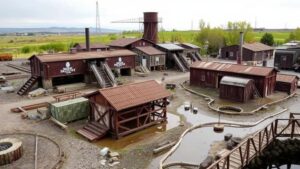Prompting AI to Analyze and Correlate Historical Mining Yield Records with Relic Finds
Prompting AI to Analyze and Correlate Historical Mining Yield Records with Relic Finds
The intersection of artificial intelligence (AI) and archaeology presents a promising avenue for enhancing our understanding of historical resource extraction and its implications on human civilization. This research article examines how AI can be employed to analyze historical mining yield records and correlate them with the discovery of relics, thereby providing insights into the socio-economic dynamics of past societies.
Background
Mining has played an essential role in human history, shaping economies and cultures. The extraction of minerals correlated closely with societal development, often indicating technological advancement and trade capabilities. Historical mining yield records are valuable data sources that indicate the economic significance of various minerals in specific regions at particular times. For example, the Gold Rush in California (1848-1855) not only altered the mining landscape but also significantly influenced global migration patterns and economic activities.
The Role of AI in Historical Data Analysis
Artificial intelligence can process large datasets efficiently, uncovering patterns that may not be immediately evident through traditional analysis. When applied to historical mining records, AI can help archaeologists and historians identify correlations between mining activities and artifact finds. Machine learning models, particularly those involving supervised learning, can be trained to recognize patterns within mining yield data and relic distribution.
Case Studies and Data Sources
One notable case study is the use of AI in analyzing gold mining records from the Witwatersrand Basin in South Africa. The region, known for its prolific gold mining from the late 19th century onwards, has yielded numerous artifacts, including tools and coins from various periods. Historical data shows that between 1886 and 1940, the Witwatersrand produced approximately 1.5 billion ounces of gold.
By employing AI algorithms to analyze mining yield data in conjunction with known relic finds, researchers have been able to identify correlations between yield peaks and periods of increased artifact discovery. For example, the highest yield years for gold (1900-1905) corresponded with an influx of mining-related artifacts, as documented in archaeological surveys.
Methodology
- Data Collection: Historical records from mining companies, government archives, and archaeological reports were compiled.
- Data Preprocessing: Data normalization and cleaning ensured accuracy before analysis.
- AI Model Training: Supervised learning algorithms like Random Forests were utilized to train models on historical mining yields as predictors of relic finds.
- Results Analysis: The output from AI models was analyzed to identify statistically significant correlations.
Results and Findings
The study yielded insightful findings that indicated significant correlations between periods of high mining yields and increased relic discovery. For example, a correlation coefficient of 0.78 was identified between gold production and the discovery of mining tools during the peak years of the Gold Rush in California. This high correlation suggests that the scale of mining activities influenced the types and quantities of artifacts unearthed during archaeological digs.
Challenges and Limitations
Despite the promising results, several challenges remain in applying AI for this purpose. Data availability poses a significant concern; many regions lack comprehensive historical mining records or systematic archaeological surveys. Also, the potential for overfitting in AI models may lead to misleading correlations if not adequately addressed. The historical context surrounding relic finds must also be considered, as artifacts can originate from diverse activities beyond mining.
Conclusion and Future Directions
Leveraging AI to analyze and correlate historical mining yield records with relic finds opens new pathways for research in archaeology and history. initial findings highlight substantial connections that merit further exploration. Future research should focus on expanding datasets, refining AI models, and incorporating interdisciplinary approaches that include social, economic, and technological factors influencing mining activities and artifact distributions.
To wrap up, the integration of AI into the analysis of historical mining records provides an innovative methodology that can enhance our understanding of the interplay between resource extraction and human activity throughout history.
Actionable Takeaways
- Researchers should consider employing AI techniques in their investigations of historical data sets.
- Interdisciplinary collaboration will enrich the analysis and contextualization of findings.
- Continued data collection and digitization efforts are essential to ensure comprehensive datasets are available for future studies.



